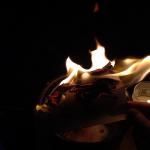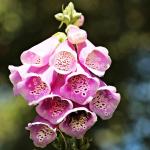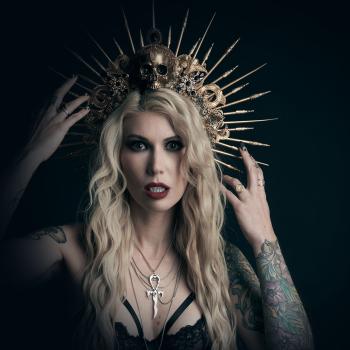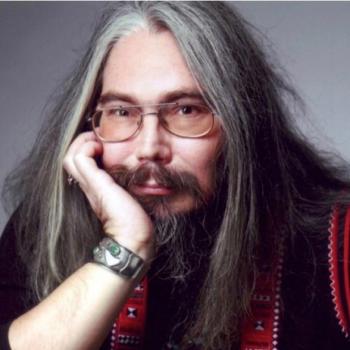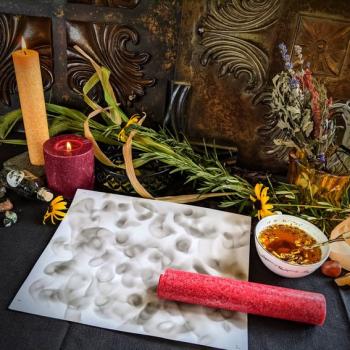The Fire Festival of Summer
The festival of Lughnasadh, later known as Lammas, is one of the four grand sabbats of witchcraft traditions, and one of the four sacred fire festivals of the Celtic peoples also celebrated by modern Pagans. The four festivals all have fire playing a central role in some way. Beltane and Samhain, the high holy days of modern witchcraft were traditionally centered around large bonfires or balefires of a sacrificial or celebratory nature. During Imbolc, or Candlemas one of the only festivals frequently celebrated indoors we see the great fire and coming sun represented by candle flame. Lughnasadh is directly across the wheel from Imbolc and during the hot-dry summer the fire of the Sun is already manifest in the sky above. Sun disks or fire wheels were also used to symbolize the solar rays of the sun, often rolled downhill in representation of the Sun’s descent over the horizon.
Summer begins with the sign of Cancer, one of the four cardinal signs that initiate each season. The sun moves in to Cancer around June 21st-22nd and remains until moving in to Leo around July 22nd. Leo is the fixed sign of the summertime, falling between cardinal Cancer and mutable Virgo. As a fixed sign, Leo is one of four pillars or elemental foundations around which the zodiac is structured. As the mid-point of the season it represents the peak of that season’s energy.
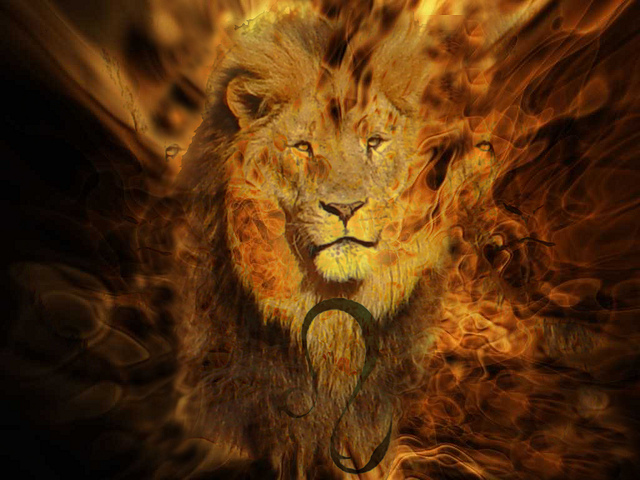 Leo. Kenyell Walker. Flickr.com
Leo. Kenyell Walker. Flickr.com
The Holy Days as Elemental Gateways
The equinoxes and solstices represent the climax and descent of the Sun’s power over the course of the year while the seasons represent the ebb and flow of elemental energy within that year. When the Sun moves in to Leo it begins the mid-point of the three summer signs. Lughnasadh marks the mid-point within a mid-point, at 15 degrees Leo it is the halfway point between the 30 degrees of the Sign.
Midpoints or in-between times have always had special significance to esoteric belief systems and nature based traditions. They are just as significant to the practice of magic and astrology. The solstices and equinoxes are gateways of solar energy affecting effecting the spiritual tides on planet Earth. We can look at the four gateways of the fixed signs as gateways of elemental energy. While the Sun occupies each elemental gateway in its fixed sign we can access the purest manifestation of that energy. In Vedic astrology the mid-point at each of the four fixed signs is known as the avatar point. Avatars are advanced celestial beings, one named for each of the visible planets and the Sun and Moon. When a planet or the Sun occupies and avatar point it gives us an opportunity to connect with and activate that particular energy.
The Creative Energy of the Sun
When the Sun occupies this point in its ruling Sign Leo we have access to the powerful creative forces of creativity and inspiration that are activated by this double fire combination. The Sun represents our individuality and personality represented by how we show ourselves to the world. Leo is a sign of creativity, vitality, the arts, and self-confidence.
By connecting with the god Lugh, whom this holy day is named for we can draw inspiration and energy that can be channeled into our creative endeavors. Lugh is the master of all arts and is part of an archetype of deities that were seen as teachers of mankind. There are many gods and goddesses that fit within this category of divine inspiration and illumination, who acted as patrons of mankind bringing us their own unique talents.
It is interesting that this time of year is a popular time for outdoor festivals, art shows, concerts and carnivals. In the middle ages this was an opportunity for the artisan guilds to display their talents and showcase their wares. Just like we see today with the popular farmer’s markets, and artisans who get together and set up booths to sell their handmade crafts; the craftsmen of the middle ages would get together and decorate their shops and stalls to present their handiwork.
The Tree of Fire and Inspiration
This is a time of knowledge, inspiration and illumination. Odin sought such knowledge when he hung himself from Yggdrasil, the World Tree, and Ash tree. The Ash is a sacred tree to a number of Celtic, Germanic and Nordic traditions, associated with the creation of mankind. It is connected to fire and the Sun, and appropriately a sacred tree of the god Lugh. Working with the Ash is appropriate this time of year. It was known for its strength and durability and was used to make many tools and weapons. It was said to be the wood used to make Odin’s spear and was also used to fashion the staffs of druids who used it as a portable representation of the World Tree. These staffs would be used to travel to the realms of earth and sky. It is also a superior word for building fires, its Latin name Fraxinus means “firelight.”
During this time of year, honor the sacred fire and the Ash tree. Thank the gods of Arte and inspiration for their many gifts, and channel the fiery energy of this time of year into your own creative endeavors. The practice of magic is an art and its patrons also fall within this category.

